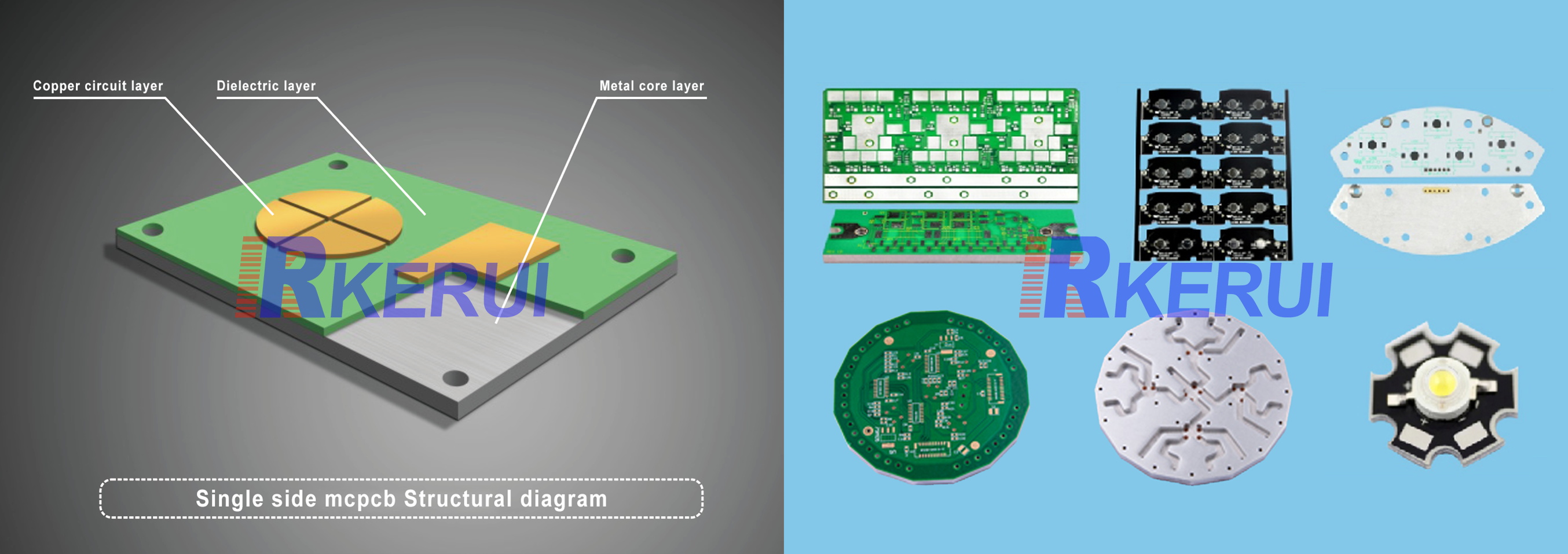Introduction of Metal Core Printed Circuit Board (MCPCB)
Heat is one of the key factors causing aging and damage to semiconductor components. Conducting the heat from semiconductor components to a heatsink for dissipation and cooling is essential for protecting these components. Among the various printed circuit boards available today, only Metal Core Printed Circuit Boards (MCPCBs) have the thermal conductivity that meets the needs of semiconductor components. Non-thermal separation MCPCBs can achieve thermal conductivity rates of 8 to 50 W/m.K, while thermal hotspot separation MCPCBs can reach up to 400 W/m.K. In contrast, other types of PCBs have thermal conductivity rates of less than 1 W/m.K.
What is Metal Core Printed Circuit Board(MCPCB)?
A Metal Core Printed Circuit Board (MCPCB), also known as a thermal PCB or metal-backed PCB, is a type of PCB that uses metal materials as the heat dissipation part of its substrate. Depending on the thermal conductivity requirements of the final product, a suitable metal plate and insulating adhesive formula are chosen. An insulating adhesive layer is applied to the surface of the metal plate, followed by a layer of copper foil. This is then processed through a thermal lamination process to create a metal-based copper clad laminate. The copper foil on the metal-based copper clad laminate is then processed into circuit boards (PCBs) using printed circuit board production techniques as needed by the electronic circuits.
Due to the metal substrate's excellent thermal conductivity, metal core printed circuit boards exhibit superior thermal performance. This effectively addresses the issue of semiconductor thermal aging and mitigates the damage caused by heat to semiconductor components, thereby ensuring the stability and reliability of electronic products in use and extending the lifespan of semiconductor products. Common types of metal core printed circuit boards include aluminum PCBs, copper PCBs, and iron PCBs.
The Basic Structure of MCPCB includes:
l Metal core layer
l Dielectric layer
l Copper circuit layer

Advantages of MCPCB
The heat transfer rate of metal core PCBs is 8 to 9 times faster than that of FR4 PCBs. MCPCB laminates can dissipate heat, keeping the temperature of heat-generating components lower, thereby improving performance and lifespan. In applications where a significant amount of heat is generated, traditional fans alone often cannot provide sufficient cooling. Thermal cooling using metal core PCBs is an ideal manufacturing option.
Excessive thermal stress can lead to PCBs operating below optimal performance or even ceasing to function entirely. Thermal stress is one of the primary causes of PCB failure. As technology advances, thermal stress often increases due to components being placed in smaller sizes. This is why effective PCB thermal management has become one of the critical factors in preventing the complete loss of functionality in electronic device systems.Another aspect is the reaction to thermal expansion, which is the process where a material expands when heated and contracts when cooled. Over time, this process can lead to weaknesses in the material, ultimately resulting in a decrease in heat dissipation efficiency. Compared to traditional PCB materials like ceramics and glass fibers, metal core PCBs such as aluminum PCBs are less prone to thermal expansion.
Applications of MCPCB
MCPCBs are generally used in PCBs that require high thermal dissipation capabilities. Therefore, their application areas typically include automotive electronics such as LED headlights and engine controls, LED lighting systems for household, commercial, and streetlights, and various consumer electronics like smartphones, tablets, and household appliances. They are also essential in communication devices such as telecom equipment and network routers, as well as smart devices including IoT devices and wearables. Additionally, MCPCBs are used in industrial control systems and medical devices where precision and reliability are critical, computing components like motherboards and graphic cards, and power supplies including units, inverters, and converters to ensure efficient cooling and stable operation.

Differences Between MCPCB and FR4 PCB?
Thermal Conductivity: The thermal conductivity of FR4 PCB is relatively low, typically around 0.3W, while MCPCB has a higher thermal conductivity, ranging from 1.0W to 4.0W, with the most common being around 2.0W.
Plated Through Holes (PTH): FR4 PCBs typically use PTH, which can accommodate through-hole components. In contrast, PTH is not suitable for single-layer MCPCBs, where all components are surface-mounted.
Heat Dissipation: Heat dissipation in FR4 PCBs typically involves thermal conduction through PTH, which can lengthen the drilling cycle and add complexity to the process. MCPCB materials inherently possess heat dissipation capabilities, and drilling can eliminate deposition and plating processes.
Solder Mask Layers: The solder mask layers of FR4 PCBs are usually dark-colored (green, red, blue, black) and are typically applied to both the top and bottom layers. In contrast, the solder mask layers of MCPCBs are primarily used for LED circuit boards and are only available on the top layer.
Thickness: FR4 PCBs come in various material compositions, layer sizes, and thicknesses. The thickness variation of MCPCBs is constrained by the available backplane thickness and dielectric board thickness.

How Does Thermal Management Using a Metal Core Board Work?
Thermal management is typically achieved using metal core boards made of copper or aluminum, where the circuit layer and dielectric layer are stacked. Transferring heat from heat-generating components to external heatsinks is crucial. Without proper thermal management, the performance of any application is at risk. High thermal conductivity materials like copper improve heat transfer; a copper core provides an excellent solution. The copper core is an alternative technology that ultimately offers higher thermal conductivity for the PCB.
The copper used in metal core bases enhances thermal conductivity while reducing the operating temperature within the components, making it an ideal choice for minimizing thermal stress on the PCB.
Thermal management is critical to PCB design because the integration and stacking of components, along with miniaturization, increase the amount of heat generated on these boards. Regardless of the chosen PCB substrate, PCB design layout, and manufacturing process, our team at Kerui can help you find the right solution for any project.
[Click to view our manufacturing capabilities]